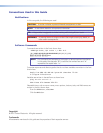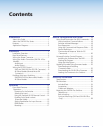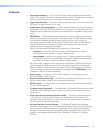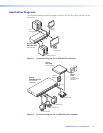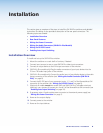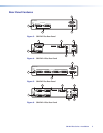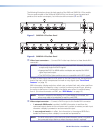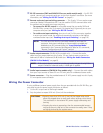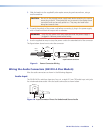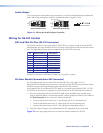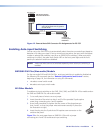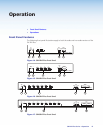
SW DVI Plus Series • Installation 6
The following illustrations show the back panels of the SW6 and SW8 DVI A Plus models.
The non-audio models of the SW6 and SW8 DVI Plus (not shown) have the same back
panels as their audio counterparts, but without audio connectors (
e
and
f
).
1
3
2
4
56
1.0A MAX
POWER
12V
SW6 DVI A Plus
DVI-D / AUDIO INPUTS
TxRx
A S
REMOTE / AUTO-SW
DVI-D / AUDIO OUTPUT
LR
6
2
4
5
7
1
Figure 7. SW6 DVI A Plus Rear Panel
6
1
3
2
4
56
7
8
1.0A MAX
POWER
12V
SW8 DVI A Plus
DVI-D / AUDIO INPUTS
TxRx
A S
REMOTE / AUTO-SW
DVI-D / AUDIO OUTPUT
LR
5
2
1
7
4
Figure 8. SW8 DVI A Plus Rear Panel
a Video input connectors — Connect DVI-D video input devices to these female DVI-I
connectors.
NOTES: • The connectors on the switcher rear panel are DVI-I. However, the switcher
accepts only single-link DVI-D signals.
• Appropriate DVI-D to HDMI cables or adapters are required for HDMI
signal input and output.
• The SW DVI Plus Series switchers are not compatible with HDCP signals.
For each of these inputs there is a DIP switch on the front panel to set the equalization
level of the input, which compensates for weak or noisy signals (see “Front Panel
Features” on page 12).
EDID information (display resolution, refresh rate, and pixel clock rate), when read from
the output display or entered by a user, is written to memory on each input, allowing
the source to perform as if connected to the display, even when it is switched away
from it. (For more information on EDID, see “EDID Modes” on page 15.)
NOTE: If power is recycled to the display, or if a new display is connected, the
source may need to be rebooted to read the new EDID.
b Video output connector — Connect a DVI-D output to this female DVI-I connector.
• If automatic EDID mode is enabled, the EDID information is read from the
connected output device via this connector and is written to memory on each input
whenever a display is powered on and connected this port.
• If user-assigned mode is in effect, the information in the assigned EDID le is
loaded into memory when a display is connected and powered on.
NOTE: The EDID information is also read and stored whenever power is recycled to
the connected output device or when the output device is replaced.



